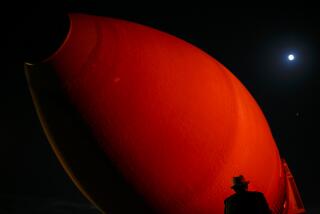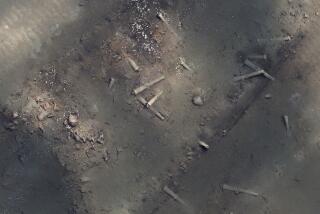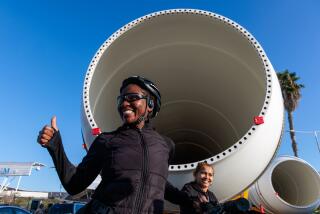San Diegans build replica sailing ship in honor of first explorer

- Share via
Reporting from SAN DIEGO — John Popp, a retired physics teacher, is making sure the cannons on the 16th century Spanish galleon under construction here are functional and historically precise.
Each cannon is more than 9 feet long and weighs more than 1,000 pounds. Each must be fitted into its sliding wooden carriage with great care.
“This is my baby,” said Popp, 73, who moved to San Diego after teaching at a community college in Illinois for three decades. He stopped for a moment to reflect on his handiwork and that of hundreds of volunteers and skilled craftsmen.
“I’ll be able to tell my grandchildren: ‘I helped build that thing,’ ” he said. “And when I’m gone, it will still be here.”
Popp, a volunteer, is part of a $6-million project of the Maritime Museum of San Diego to build a full-scale, working replica of the San Salvador, the flagship of explorer Juan Rodriguez Cabrillo when he arrived in San Diego Bay on Sept. 28, 1542.
Historians rate Cabrillo as the first European to set foot in California. Museum officials hope the San Salvador will draw visitors to their waterfront museum and reaffirm San Diego’s claim as the place where modern California began.
When the ship is completed — organizers hope by next summer — the San Salvador will be moored beside the museum, offering day trips and overnight cruises.
Cabrillo is afforded hero status in San Diego. The Cabrillo National Monument, operated by the National Park Service, stands at the southern tip of the Point Loma peninsula, complete with a 13-foot-tall statue of Cabrillo.
An annual festival celebrates Cabrillo’s arrival. A volunteer in a period costume wades ashore at Ballast Point to represent Cabrillo. This year’s festival, set for Sept. 27 and 28, will be the 51st annual. There is pent-up demand for this year’s celebration to be particularly festive.
Last October, the partial shutdown of the federal government forced the National Park Service to cancel a centennial commemoration of the 1913 proclamation by President Woodrow Wilson that ordered construction of “a heroic statue of Juan Rodriguez Cabrillo.”
The dream of building a replica of the San Salvador took hold nearly three decades ago at the Unified Port District of San Diego. A naval architect was hired to scour for information about the ship’s dimensions because no building plans, if they ever existed, remain intact.
The project was scuttled by the recession of the 1990s. The idea was revived a few years ago by the Maritime Museum, which already has as its flagship the Star of India, built in 1863 and billed as the world’s oldest working sailing ship.
There is strong competition in San Diego for the attention of tourists curious about the city’s maritime history. In 2004, the carrier museum Midway, run by a different organization, opened near the maritime museum and is now touted as the most popular U.S. Navy ship museum in the country.
The job of devising plans for the San Salvador fell to museum trustee Doug Sharp, a San Diego naval architect and yacht designer. He studied notations on charts, iconography and a manuscript from 1587 that contained information about the rigging.
Construction began in April 2011. “We expected difficulty,” Sharp said, “but we didn’t expect the degree of difficulty.”
One problem involved the planned use of laminated white oak. The lamination process was a flop. “It was a major setback,” Sharp said.
Through trial and error, different kinds of wood were deemed best for different parts of the ship: tropical hardwood from Nigeria (found in Germany by a wood broker), southern live oak from Georgia, live oak from the East Coast, Douglas fir from Oregon and purpleheart from Guyana.
Plans call for the San Salvador to be 111 feet long, and 78 feet from waterline to the top of the mast. Weight: about 200 tons. Like the original, the ship will have three sails.
“I’m hoping that if Cabrillo came back and walked on its deck, he’d say, ‘Yes, this looks like my ship,’ ” said Mark Montijo, the museum’s vice president and chief administrative officer. “Of course, if he went below deck, that would be different.”
Beneath the deck are watertight bulkheads and an auxiliary power source. The ship will have twin propellers driven by two 280-horsepower engines.
So far, $4.5 million has been raised, about a third from the California State Coastal Conservancy. Seven foundations, companies and individuals each have given $100,000 or more. More than 500 donors have given smaller amounts.
Guided tours of the working site at Spanish Landing across from Lindbergh Field go for $5. A small tent serves as a gift store, where Cabrillo-iana such as books, T-shirts, key chains, shot glasses and coasters can be purchased. A $300-a-ticket gala (“San Salvador Fandango”) is set for Sept. 27.
The $6-million cost might have gone even higher if much of the work had not been done by several hundred volunteers, including chemists, plumbers and retired Navy personnel.
Martin Cassel, 64, a retired medical technician, is assisting Popp on the “bombardetta and carriage” part of the project. He had initially come to the site with an out-of-town guest.
“I was immediately hooked,” Cassel said. “How often in your life do you find something like this to do?”
tony.perry@latimes.com
Twitter: @LATsandiego
More to Read
Sign up for Essential California
The most important California stories and recommendations in your inbox every morning.
You may occasionally receive promotional content from the Los Angeles Times.













